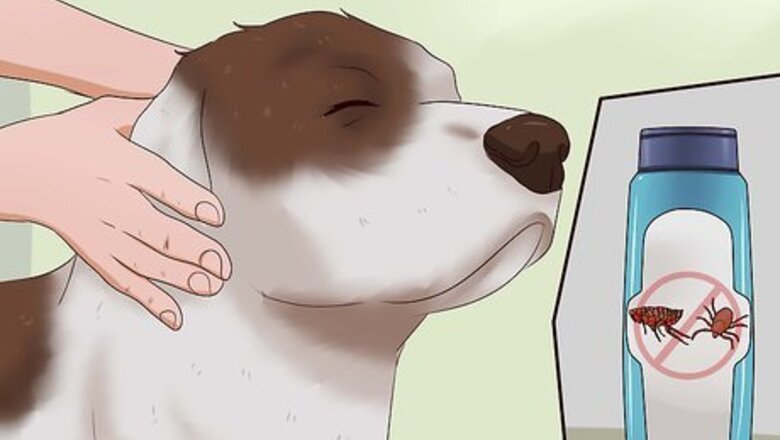
views
Administering Medicated Treatments

Wash your dog with flea and tick shampoo. While normal dog shampoo and dish detergent usually kill fleas, if you need something more potent, you could try a special flea and tick shampoo. Read the shampoo label carefully to determine the proper way to use the shampoo for your dog. Soak your dog with warm water and rub the flea shampoo into its fur. Let the shampoo sit on the dog's coat for at least 10 minutes before rinsing it off with warm water. Flea shampoos usually contain pyrethrins, a type of chemical used to kill fleas. Flea shampoos kill fleas and ticks that are already on the dog.
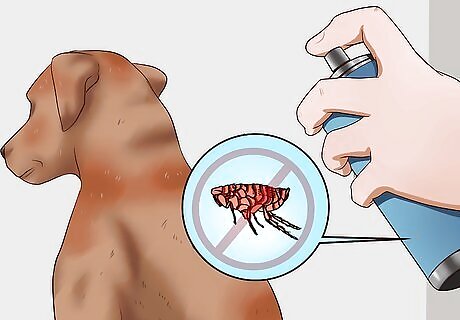
Purchase a flea spray. Flea and tick sprays are available in both aerosol and pump bottle forms. For best results, choose a spray that contains an adulticide and an insect growth regulator. Doing so will ensure that both adult fleas and their eggs are killed. Follow your veterinarian's instructions and the instructions on the label for proper use. Spray in a well-ventilated area and avoid getting the spray in your dog's eyes. Wear gloves while administering the spray to protect yourself. When spraying sensitive areas, such as the face, spray the product onto your glove and rub it on the dog rather than risking spraying in the dog’s eyes, mouth, or ears.
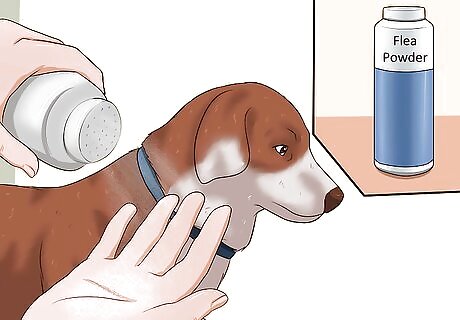
Try a flea powder. Flea powder is can usually be purchase without a veterinarian's prescription and works in the same way that a spray works. Read the instructions on the label to determine proper use. If you are uncertain about anything, ask your veterinarian before applying the powder to your dog. Usually, you apply a powder by dusting a fine layer over your dog's coat and letting it sit undisturbed. Note, however, that powders tend to make the coat feel gritty and need to be reapplied often. Begin at the dog’s head and work back towards the tail, ensuring that the powder gets all the way to the dog’s skin. Also sprinkle the powder on the dog’s bedding. Repeat once per week if necessary.
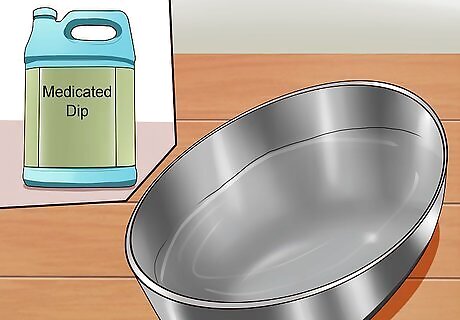
Prepare a medicated dip. Dips and rinses should be applied to your dog's coat after flea infestation has started. Mix the dip or rinse as directed by the package label. Ask your veterinarian for further instructions. A dip, also referred to as a flea bath, requires you to soak your dog in a diluted, medicated solution. A rinse is a medicated solution that you pour over your dog's coat until it is soaked. Apply both to the entire dog, and do not attempt to use as spot treatments. Use dips and rinses in well-ventilated areas. Most flea dips should be left on your dog, not rinsed away. These products usually contain chemicals known as pyrethrins, permethrins, and organophosphates.

Put a flea collar on your dog. Flea collars vary greatly in quality, and many of them have a limited range of activity, only killing fleas that are near the collar (around the dog’s head and shoulders). However, high-quality flea collars can help repel or kill fleas when used properly. Be sure to select a collar that is appropriate for your dog’s age and weight. Slip two fingers under the collar to determine if it is snug enough without being too tight. Cut off any excess length from the collar after you put it around the dog's neck. Do not let the dog chew on the end of the collar. Familiarize yourself with the label instructions so that you know how long the collar should last and what to avoid. Some collars become less effective when wet. Monitor the dog's neck beneath the collar and remove the product if its skin becomes irritated.
Using Preventative Flea Remedies
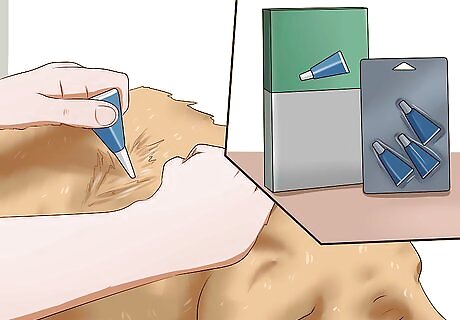
Apply a monthly topical. Monthly topical treatments are among the most effective and most popular type of preventative flea medication for dogs. You will need a veterinarian's prescription for most of these topical or "spot on" treatments. Apply a few drops or a small pre-measured vial of the flea medication where it tells you to. Some medicines tell you to apply between your dog's shoulder blades while others ask you to apply it in several different locations. Get the medication directly on your dog's skin and not on its coat. This medication kills adult fleas that land on the dog or bite the dog. It is usually effective for one month. Some products are also able to kill eggs, but not all products do so. The medication should be applied monthly on a year-round basis. If you live in an area that regularly reaches the freezing point during winter, however, you might be able to use the product less frequently during these colder weather months, since fleas will be inactive.

Feed your dog a monthly flea tablet. Ask your veterinarian about preventative tablets that you can administer to your dog on a monthly basis. Feed the pill to your dog once a month during a meal. Your veterinarian will need to prescribe the correct dosage to your dog based on its weight. When a female flea bites the dog after treatment, it ingests a chemical known as lufenuron. This gets passed to the eggs and prevents them from hatching. (It does not, however, kill the adult flea, so the results may take some time to see). As with any treatment, it's worth keeping an eye on how your dog reacts. Look at the place you put the treatment to make sure there is no reaction and do not use it again if the dog's skin goes red or sore.
Trying Natural Flea Treatments

Wash your dog. Oftentimes, washing your dog with warm water and a mild liquid dish soap or a simple dog shampoo will kill most if not all fleas on the dog. This treatment is best done to treat mild to moderate flea outbreaks, but it may not be potent enough to kill fleas in large numbers. Only use a mild dish detergent free from added dyes and perfumes and safe for use on sensitive skin. Stop treatment if your dog has a bad reaction to the soap. Follow the use of dish soap with a conditioner made for dogs to counteract its drying effects. Lather and rinse the dog once per week. Washing a dog more often (particularly with dish soap) can cause damage to the dog’s skin by drying him out. Soap traps fleas and lifts them off the dog. Additionally, it disrupts the cell membranes of the fleas and removes their protective waxes. As a result, the flea can no longer retain water and dies from dehydration.
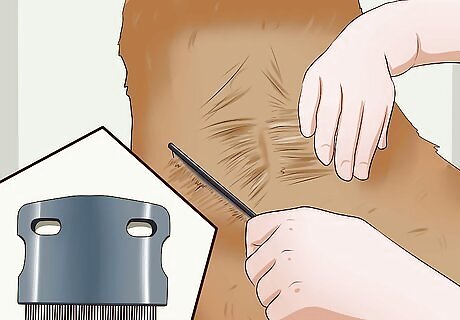
Comb your dog with a special flea comb. You can use a comb sold specifically as a flea comb, but you could also use any fine-toothed comb with very small gaps in between the teeth. Flea combs physically lift fleas out of your dog's coat. Comb your dog from top to bottom. As you comb, make sure that the comb reaches the dog's skin. If you only comb the fur without reaching the skin, some fleas may remain even afterward. You should immediately dip your flea comb into a bucket or dish of warm, soapy water once you remove a flea. This soapy concoction should be able to kill the fleas.
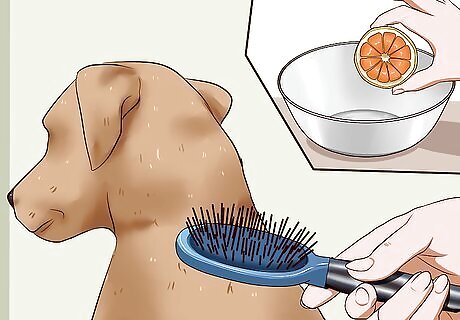
Repel fleas with lemon juice. Applying diluted lemon juice to your dog's fur should help kill or fleas. Use caution, however, that you do not over-dry your dog’s skin with the lemon. Mix equal parts lemon juice and warm water in a shallow bowl. Alternatively, you could cut a lemon into quarters and cover it with boiling water. Let the mixture steep for eight hours or overnight before straining the liquid into a bowl. Dip a dog’s brush or comb into the lemon mixture and brush the dog, coating the fur with lemon through contact with the brush. Be sure to brush the dog thoroughly, dipping the brush in the mixture with every other stroke or so. Repeat this procedure once daily for three days.
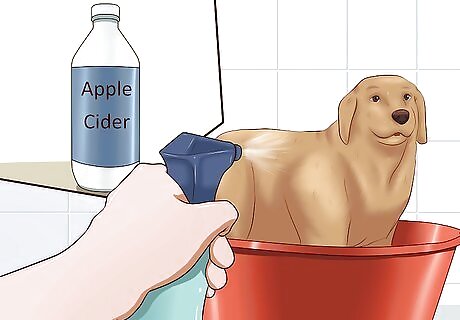
Treat your dog with apple cider vinegar. The apple cider flea remedy can be given to your dog topically. Mix equal parts apple cider vinegar and warm water in a spray bottle. Coat your dog with the repellant, spraying it all over the coat but focusing on areas where fleas are prone to gather, like behind the ears, at the base of the tail, and under the legs. If you dog's skin becomes unusually dry or if you suspect that your dog is having a negative reaction to the vinegar, stop treatment immediately.
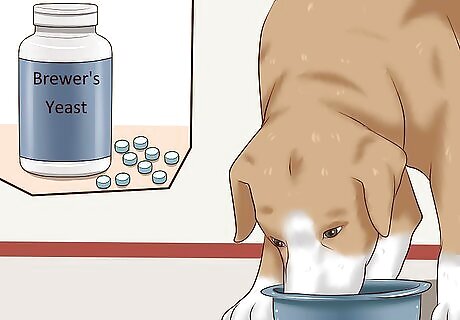
Try brewer's yeast. Brewer's yeast is a natural preventative treatment and presents an alternative to harsher chemical remedies. There has been mixed evidence of its efficacy, but it seems as though active yeast has more of an effect on the number of fleas. Add a Brewer's yeast tablet to your dog's food once every day or two. Ask your veterinarian to determine the best dosage based on your dog's age and weight. Do not attempt to determine the dosage without approval from your veterinarian. The Brewer's yeast eventually seeps into the dog's skin and gets excreted through the dog's pores. As a result, the skin and coat become less appealing to fleas, effectively repelling them.
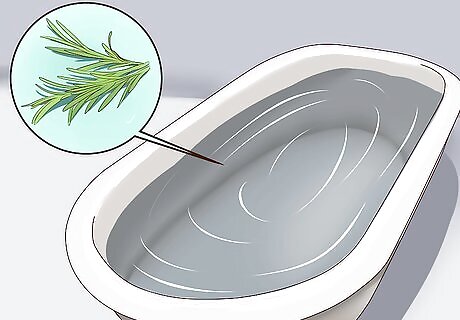
Prepare a rosemary flea dip. This approach has not been scientifically proven, but there is some anecdotal evidence that it may be effective in repelling fleas. Soak your dog with rosemary-infused water and let it dry naturally. Steep 2 cups (500 ml) of fresh rosemary sprigs in boiling water for 30 minutes. Use enough water to cover the rosemary completely. Strain the liquid and discard the leaves. Add up to 1 gallon (4 L) of warm water to the rosemary water. Use less water for a small dog. Let the temperature of the rosemary water cool slightly. It needs to be warm, but it should not be so hot that it burns your pet. Pour the water over the dog, drenching him/her completely. Let air dry.
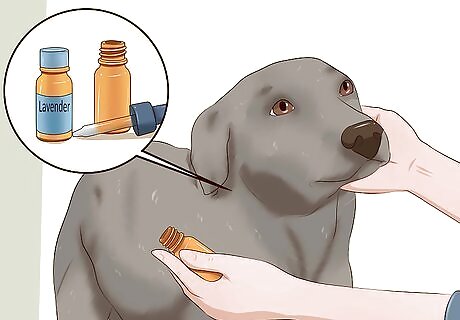
Apply lavender essential oil. This approach has not been scientifically proven, but there is some anecdotal evidence that it may be effective in repelling fleas. You only need to use a few drops of lavender oil in a few key places to take advantage of this effect. Wash your dog normally with warm water and soap. Dry the dog using a towel. Apply a few drops of lavender essential oil to the base of the tail and a few at the back of the neck. Use your fingers to gently massage the oils into your dog's coat and skin.

















Comments
0 comment